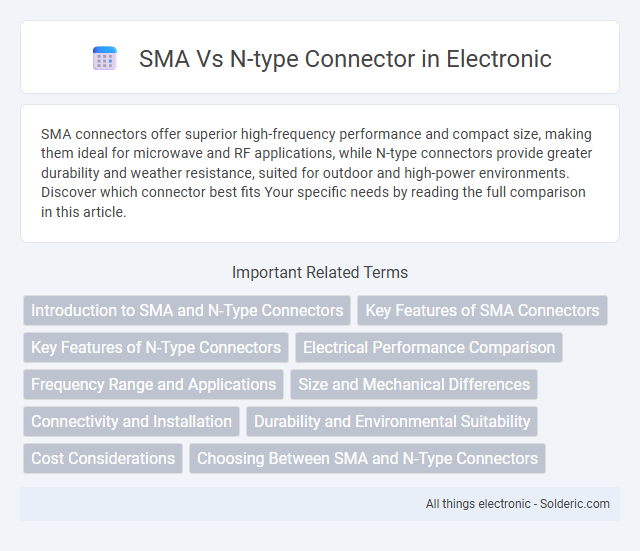SMA connectors offer superior high-frequency performance and compact size, making them ideal for microwave and RF applications, while N-type connectors provide greater durability and weather resistance, suited for outdoor and high-power environments. Discover which connector best fits Your specific needs by reading the full comparison in this article.
Comparison Table
| Feature | SMA Connector | N-Type Connector |
|---|---|---|
| Frequency Range | Up to 18 GHz (some variants up to 26.5 GHz) | Up to 11 GHz (some precision types up to 18 GHz) |
| Impedance | 50 Ohms | 50 or 75 Ohms |
| Connector Size | Small, compact (about 8 mm diameter) | Larger, rugged (approx. 21 mm diameter) |
| Applications | High-frequency RF, microwave, test equipment | Outdoor uses, base stations, antennas, heavy-duty RF |
| Durability | Medium; suited for lab environments | High; weatherproof, supports rugged environments |
| Coupling Mechanism | Threaded (1/4"-36 thread) | Threaded (5/8"-24 thread) |
| Power Handling | Low to medium power | High power, typically up to several hundred watts |
| Material | Stainless steel or brass with gold plating | Brass or stainless steel with weatherproof seals |
Introduction to SMA and N-Type Connectors
SMA connectors are precision coaxial connectors designed for high-frequency applications up to 18 GHz, commonly used in RF and microwave systems due to their compact size and reliable thread-coupling mechanism. N-type connectors are larger, weatherproof connectors ideal for outdoor and heavy-duty applications, supporting frequencies up to 11 GHz with excellent power handling and low signal loss. Both connectors serve critical roles in signal transmission, with SMA favored for high-frequency, low-power environments and N-type preferred for robust, high-power, and outdoor operations.
Key Features of SMA Connectors
SMA connectors feature a threaded coupling mechanism that ensures secure, vibration-resistant connections ideal for high-frequency applications up to 18 GHz. Their compact size and excellent electrical performance, including low signal loss and stable impedance, make them widely used in RF and microwave systems. SMA connectors are also known for their durability and ability to maintain consistent performance in harsh environmental conditions.
Key Features of N-Type Connectors
N-Type connectors feature a threaded coupling mechanism that ensures a secure and reliable connection ideal for high-frequency applications up to 11 GHz. They provide excellent durability with weatherproof designs, often used in outdoor and industrial environments requiring superior performance under harsh conditions. Their larger size compared to SMA connectors allows for higher power handling and better mechanical stability in RF and microwave systems.
Electrical Performance Comparison
SMA connectors deliver excellent electrical performance with a frequency range up to 18 GHz and low VSWR, making them ideal for high-frequency RF applications. N-type connectors operate reliably up to 11 GHz, providing higher power handling and better durability due to their larger size, which is advantageous in outdoor environments. Your choice between SMA and N-type should weigh the trade-off between frequency capability and power requirements for optimal signal integrity.
Frequency Range and Applications
SMA connectors support frequencies up to 18 GHz, making them ideal for microwave applications, wireless communication, and radar systems. N-type connectors operate effectively up to 11 GHz, commonly used in antennas, broadcast, and telecommunications equipment. Both connectors provide reliable performance, but SMA connectors are preferred for higher frequency precision, while N-type connectors excel in rugged outdoor environments.
Size and Mechanical Differences
SMA connectors are smaller with a threaded coupling mechanism, measuring approximately 8mm in diameter, making them ideal for compact RF applications. N-type connectors are larger, about 21mm in diameter, featuring a robust threaded design suited for higher power and outdoor environments. The mechanical durability of N-type connectors exceeds that of SMA connectors, providing greater resistance to environmental factors and mechanical stress.
Connectivity and Installation
SMA connectors feature a screw-type coupling mechanism that ensures secure, durable connections, making them ideal for high-frequency applications requiring reliable signal integrity. N-type connectors use a threaded coupling system designed for higher power handling and better environmental sealing, suitable for outdoor or rugged installations. Both connectors offer straightforward installation, but SMA connectors are preferred for compact, precision applications while N-type connectors excel in robustness and ease of maintenance in larger cable assemblies.
Durability and Environmental Suitability
SMA connectors offer superior durability with a robust threaded coupling mechanism, making them highly resistant to vibration and mechanical stress. N-type connectors are designed for outdoor and harsh environmental conditions, featuring weatherproof seals that ensure reliable performance in moisture and dust exposure. Your choice depends on whether you prioritize mechanical sturdiness (SMA) or environmental resilience (N-type) for your specific application.
Cost Considerations
SMA connectors typically offer lower costs due to their widespread use in commercial applications and mass manufacturing. N-type connectors are generally more expensive because of their robust design suitable for higher power handling and outdoor environments. Budget constraints often favor SMA connectors for indoor, low-power setups, while N-type connectors are chosen when durability and performance justify the higher investment.
Choosing Between SMA and N-Type Connectors
Choosing between SMA and N-Type connectors depends on frequency range and application requirements. SMA connectors are ideal for high-frequency signals up to 18 GHz, offering compact size and precision in RF and microwave communications. Your decision should consider N-Type connectors for lower frequencies up to 11 GHz, providing robust durability and weather resistance in outdoor and heavy-duty environments.
SMA vs N-type connector Infographic

 solderic.com
solderic.com